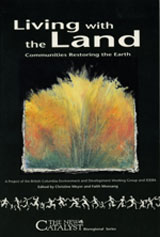
Living with the Land
Communities Restoring the Earth
Meyer, Christine; Moosang, Faith
Publisher: New Society Publishers/New Catalyst Bioregional Series, Canada
Year Published: 1992
Pages: 131pp Price: $9.95 ISBN: 1-55092-193-2
Library of Congress Number: HC79.E5L58 1992 Dewey: 333.7'15'091724
Resource Type: Book
Cx Number: CX6356
A collection of stories from grassroots communities about the benefits of ecological living.
Abstract:
A collection of stories from grassroots communities about the benefits of their way of living. They use their resources in a way that is sustainable both ecologically and economically. There are 18 success stories from communities all over the world from people who are satisfied with their relationship with nature. The goal is to avoid environmental crises, decrease pollution and renew resources without using them up.
The book is divided into four parts: Folks in the Forest, Folks Planting Seeds, Folks in the Fields and Folks in Cities and Towns. Each section provides several specific examples and first-hand accounts from the groups
who live with the land, not off it. They call it bottom-up development, where instead of assuming that development is part of economic growth, communities have control over how they use the land and water, and thus base their development on a good relationship with nature.
This is a project of the British Columbia Environment and Development Working Group that seeks to re-ignite the hope that the Earth can still be restored and the damage caused by top-down development repaired. The sections of the book were written from people around the world who have been part of grassroots communities and report many benefits.
[Abstract by Mia Manns]
Table of Contents
Acknowledgments
Foreword: Of Cargo Cults and Conferences,
Christopher Plant
By Word of Mouth: An Introduction,
Christine Meyer and Faith Moosang
Part One: FOLKS IN THE FOREST
1. Building Community on Ancestral Ground: The Ikalahan People
The Ikalahan Elders
2. Regaining the Forest, Land, and Dignity: The Ulkatcho and Kluskus People
Bert Groenenberg
Wholistic Forest Use: What it Really Means
Herb Hammond
3. Stepping Lightly with Heavy Hooves: Horse Logging in British Columbia
Doug Gook
4. From a House without Walls: Friends of Nature, Friends of Life
Ramon Silva
The Mindo-Nambillo Forest Reserve, Ramon Silva
5. Education for Life: The Hill Tribe Development Project
Busaba Paratacharya and Suphan Inphu
Part Two: FOLKS PLANTING SEEDS
6. A Pocketful of Seed: Saving Old Varieties in Indonesia
Chandra Kirana
Giving Back, Chandra Kirana
7. Putting Culture Back into Agriculture: Collective Action to Save Seeds
Thomas Evans
8. The Plant Breeders' Rights Act: What It Really Means
GROW(Genetic Resources for Our World)
Part Three: FOLKS IN THE FIELDS
9. Learning to Love the Land Again: Campesinos Empowering Campesinos
Richard McDermott
The Campesino a Campesino Program
Greg Utzig
10. On the Edge of a Disappearing Forest: Traditional Farming Systems in Transition
Lucy & Larry Fisher, Stefan Wodicka, and Putra Suardika
11. Finding Local Solutions: What it Really Means
Gus Polman
12. Enduring the Wind, Announcing the Rain: Cultural Endurance in Nigeria
Mark Lutes
13. Healing by Tradition: Herbs and Liberation Theology in Honduras
Philip Tamminga
A Song of Health, The Community of Siete Cuchillas
Part Four: FOLKS IN CITIES AND TOWNS
14. Overcoming Barriers in the Barrio: Organizing in Barrio San Jorge
Lorenza, Quela, Estela, Susana, Brenda, Margarita & Ignacio (Barrio San Jorge); also Ana & Jorge E. Hardoy,
With Richard Schusterman
15. Restoring the City: Curitiba, the Ecological Capital of Brazil
Jonas Rabinovitch
16. Gardening for a Change: Strathcona Community Garden
Strathcona Community Gardeners
17. Fishing for a Voice: Grassroots Organizing among Small Fisherfolk
Antonio M. Austria
The (Un)making of a Fisheries Law
Tess H. Lingan and Tony Debuque
18. A Community of Intention: Huehuecoyotl
Alberto Ruz Buenfil
Subject Headings


